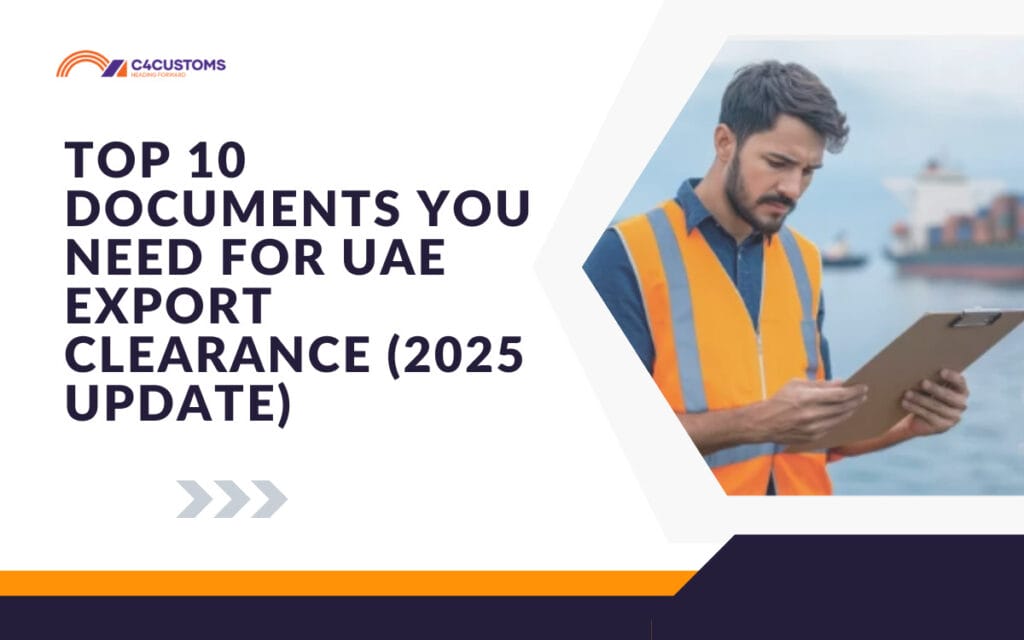Top 10 Documents You Need for UAE Export Clearance (2025 Update)
August 5, 2025. C4CUSTOMS
Introduction:
Exporting goods from Dubai or anywhere in the UAE in 2025 requires strict compliance with updated customs procedures and documentation standards. Whether you are shipping commercial items, industrial materials, or specialized cargo, having the correct paperwork is non-negotiable for avoiding penalties or delays. This guide outlines the top 10 essential export documents required for smooth customs clearance in the UAE under the latest regulations.
Why Documentation Matters for Export Clearance in 2025
The UAE has modernized its customs infrastructure through platforms like Mirsal 2, making digital declarations and HS code alignment mandatory. Exporters must prepare documents that align with the 2025 12-digit HS code structure, customs valuation methods, and free zone/multiple jurisdiction requirements.
✅ Top 10 Export Documents Required for UAE Customs Clearance
1. Commercial Invoice
The commercial invoice must detail the goods’ description, quantity, unit value, total price, Incoterms (e.g., FOB/CIF), and exporter/importer details. It must match all other documents and use accurate values.
2. Packing List
This includes information on weight, packaging type, number of cartons, and dimensions of the cargo. Customs uses it to verify container loading, storage, and inspections.
3. Certificate of Origin (COO)
Issued by your local Chamber of Commerce, this document verifies the origin of goods and affects duty exemptions under trade agreements like GCC Unified Economic Agreement.
4. Export Declaration (via Mirsal 2)
The UAE’s customs portal Mirsal 2 is mandatory for submission of export declarations. You must declare goods digitally with the correct HS code, exporter details, and consignee information.
5. Export Permit (If Applicable)
Required for restricted goods such as electronics, chemicals, medical supplies, or dual-use items. These permits must be obtained from regulatory bodies like the Ministry of Economy or MOFA.
6. Bill of Lading (Sea) / Airway Bill (Air)
Issued by the shipping line or airline, these documents act as proof of carriage. It must match the invoice and declaration for clearance and tracking.
7. Trade License Copy (Exporter)
Exporters must submit a valid UAE Trade License showing authorized trading activities relevant to the goods being exported.
8. Emirates ID / Passport Copy of the Signatory
Some customs processes may require the identity documents of the authorized signatory, especially for SMEs or direct exporters.
9. Delivery Order from the Shipping Line / Freight Agent
This is required to release the goods to the exporter. It’s often needed alongside the Bill of Lading.
10. NOC or Special Approvals (If Required)
In some cases, a No Objection Certificate (NOC) or approval may be needed from authorities like Dubai Municipality, SIRA, or Ministry of Health for product categories like cosmetics, electronics, or medical items.
📋 Want Help With Documentation?
We assist exporters with document preparation, digital Mirsal 2 submission, and customs coordination to ensure your cargo is processed without any delays or errors.
Visit our [Export Documentation Services Page] for full support.
📦 Additional Tips for Exporters in 2025:
Use only 12-digit HS codes introduced by Dubai Customs in 2025
Verify all documents match your commercial invoice
Double-check consignee details for accuracy
For free zone exports, use the proper declaration code like FZ to LG (Local GCC)
Check for restricted item classifications before shipment
✈ Where We Operate:
C4Customs handles export clearance across:
Final Thoughts:
Export clearance in the UAE doesn’t need to be stressful — but it must be handled with precision. With evolving customs rules and digitization under Mirsal 2, partnering with an experienced agent like C4CUSTOMS can help you avoid documentation errors, shipment delays, or compliance issues.
📞 Need support? Contact our export agents today or request a quote.
Let us handle the customs — so you can focus on growing your global trade.
Tags: UAE Export Documents, Export Clearance Dubai, Mirsal 2, HS Code 2025, Dubai Customs Agent, Certificate of Origin, Export Permit UAE
📍 Location: C4 Customs, Fast Business Centre – Al Qusais 2, Dubai, United Arab Emirates
📧 Email: Clearingagent2016@gmail.com
📱 Call Us: +971529138991
Frequently Asked Questions
You’ll need a commercial invoice, packing list, certificate of origin, export declaration (via Mirsal 2), and a valid UAE trade license. Additional permits or approvals may be required depending on the goods.
Export declarations must be submitted digitally through Mirsal 2, Dubai Customs’ online platform. The submission must include the correct 12-digit HS code, consignee details, and supporting documents.
Yes, the Certificate of Origin (COO) is essential for most export shipments. It’s issued by the Chamber of Commerce and confirms the country of manufacture, affecting duty exemptions in destination countries.
A Bill of Lading (or Airway Bill for air cargo) is proof of cargo carriage issued by the shipping line or airline. An Export Declaration is a digital customs submission required for customs clearance in the UAE.
Yes. Missing or incorrect export documents can lead to shipment delays, fines, or seizure. Always ensure accuracy in your commercial invoice, declaration, HS code, and supporting papers.
Absolutely. Companies like C4CUSTOMS offer expert documentation support, Mirsal 2 filing, and full customs coordination to ensure your shipment clears smoothly and on time.

